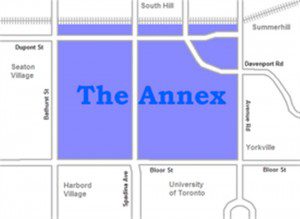
The Annex
The Annex is a neighbourhood in downtown Toronto, Ontario, Canada. The traditional boundaries of the neighbourhood are north to Dupont Street, south to Bloor Street, west to Bathurst Street and east to Avenue Road. The City of Toronto recognizes a broader neighbourhood definition that includes the adjacent Seaton Village and Yorkville areas. Predominantly English-speaking, it is an affluent neighbourhood with well-educated residents. According to the 2006 Canadian census, the neighbourhood has a permanent population of 15,602 with an average income significantly above average in the Toronto census metropolitan area.
The Annex is mainly residential, with tree-lined one-way streets lined with Victorian and Edwardian homes and mansions, most of them built between 1880 and the early 1900s. The 1950s and 1960s saw the replacement of some homes and mansions with mid-rise and a handful of high-rise apartment buildings in the International style. These were surrounded with landscaped green spaces in an attempt to better fit into the neighbourhood. Because of its proximity to the university, the Annex has a high rate of seasonal tenant turnover, and its residents range from university students to older long-time residents. The stretch of Bloor Street between St. George and Bathurst is a vibrant social and mixed-use area, offering Toronto a wide range of services from moderate-priced dining to independent discount retailers, in buildings which often include residential space in upper floors. Just west of the Annex proper, between Bathurst and Christie, street signs on that stretch of Bloor call it Koreatown, although the neighbourhood north of Bloor Street is usually called Seaton Village or the “West Annex”.
The Robert Brown House, an Annex style house owned by the University of Toronto
The Annex is home to many examples of a uniquely Torontonian style of house that was popular among the city’s elite in the late nineteenth century. Examples of this style survive in the former upper class areas along Jarvis and Sherbourne Street and also within the University of Toronto campus. Most of these buildings are found in the Annex, and the style is thus known by some as the ‘Annex style house.’
The original conception is attributed to E.J. Lennox, the most prominent architect in late nineteenth century Toronto. His 1887 design for the home of contractor Lewis Lukes at 37 Madison Avenue introduced a design that would be imitated and modified for the next two decades. The Annex style house borrows elements from both the American Richardson Romanesque and the British Queen Anne Style. Annex style houses typically feature large rounded Romanesque arches along with Queen Anne style decorative items such as turrets. Attics are emphasized in the exterior architecture. The houses are most often made of brick, though some also incorporate Credit Valley sandstone. Built for many of the city’s wealthiest citizens, the houses are also large. As the wealthy moved away from the neighbourhood, many of the houses were thus subdivided into apartments.

